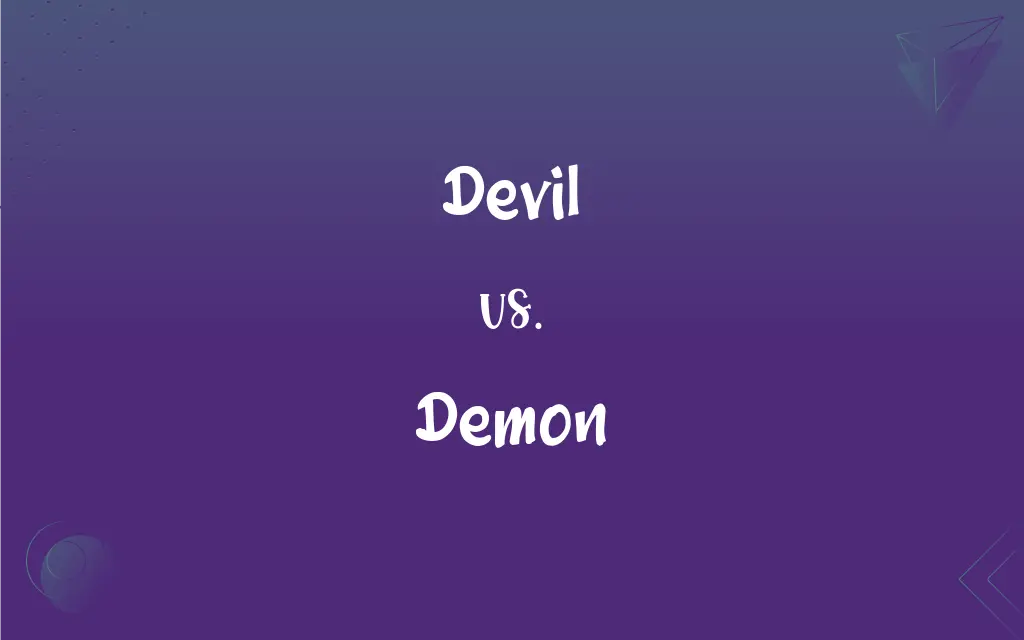Devil vs. Demon: What's the Difference?
Edited by Aimie Carlson || By Harlon Moss || Published on January 2, 2024
The devil is often viewed as a singular, supreme evil being, while demons are typically considered lesser, malevolent supernatural entities.

Key Differences
The term "devil" commonly refers to a singular, principal figure of evil in various religious traditions, often seen as a tempter or adversary of humanity. In contrast, "demons" are generally considered a class of malevolent supernatural beings, subordinate to a higher evil power, involved in harming or tempting humans.
The devil is depicted as a central antagonist in many belief systems, embodying ultimate evil or moral corruption, while demons are usually portrayed as minions or followers, carrying out malevolent acts. Demons often have less autonomy compared to the devil, who is typically seen as a mastermind of evil.
In many cultural narratives, the devil is a specific entity with unique characteristics and a significant role in religious or mythological stories. Demons, on the other hand, are often presented as a collective group, each with individual traits but generally serving similar malevolent purposes.
The devil is often associated with higher-level temptations or existential threats to goodness and morality, often personifying ultimate evil. Demons tend to represent more localized or specific forms of evil, often tasked with tempting, deceiving, or directly harming individuals.
In literature and popular culture, the devil is frequently portrayed as a cunning, charismatic figure, while demons are depicted as more straightforwardly malevolent and often less complex.
ADVERTISEMENT
Comparison Chart
Role in Belief Systems
A singular, principal figure of evil
Lesser, malevolent supernatural entities
Autonomy and Power
Often depicted as a mastermind with higher autonomy
Usually portrayed as minions or followers
Representation
Specific entity with unique characteristics
Part of a collective group with individual traits
Symbolism
Embodies ultimate evil, higher-level temptations
Represents localized, specific forms of evil
Cultural Portrayal
Cunning, charismatic
Straightforwardly malevolent, less complex
ADVERTISEMENT
Devil and Demon Definitions
Devil
A character representing moral corruption and temptation.
The devil was blamed for leading people astray.
Demon
A representation of specific, localized forms of evil.
In the legend, the demon caused chaos in the village.
Devil
A supreme evil being in various religions.
The devil is often depicted as the tempter in religious texts.
Demon
A creature associated with harm, deception, or temptation.
The demon in the story tricked the hero with illusions.
Devil
A central figure symbolizing ultimate evil.
In folklore, the devil makes deals with unsuspecting mortals.
Demon
An evil being in folklore, often with unique traits.
Each demon in the mythology had its own terrifying power.
Devil
A singular antagonist in mythological and religious narratives.
The story described the devil’s fall from grace.
Demon
A minion in various belief systems, serving higher evil powers.
The demons were depicted as servants of darkness.
Devil
A metaphor for the highest form of evil in cultural stories.
In many cultures, the devil is a symbol of life's temptations.
Demon
A malevolent supernatural entity, often lesser than the devil.
The ancient texts spoke of demons tormenting the lost souls.
Devil
Often Devil In many religions, the major personified spirit of evil, ruler of Hell, and foe of God. Used with the.
Demon
An evil supernatural being; a devil.
Devil
A subordinate evil spirit; a demon.
Demon
A persistently tormenting person, force, or passion
The demon of drug addiction.
FAQs
What is a demon?
A demon is typically considered a malevolent supernatural entity, usually lesser in power than the devil.
Is the devil always seen as evil?
In most cultures and religions, the devil is associated with evil and moral corruption.
Can demons act independently?
Demons often act under the direction or influence of a higher evil power, like the devil.
Can demons take physical forms?
In many traditions, demons are believed to have the ability to manifest in various physical forms.
Do all cultures have a concept of demons?
Many cultures have entities that could be classified as demons, though they may vary in characteristics.
Can the devil be defeated?
Many cultural narratives involve stories of the devil being outwitted or defeated.
Are demons always lesser than the devil?
Typically, yes, demons are considered lesser beings compared to the devil.
Is the devil a part of all religious beliefs?
Not all, but many religions have a concept of a principal evil being similar to the devil.
Are demons and the devil the same?
No, the devil is usually a singular figure, while demons are numerous and subordinate.
Is the devil always a male figure?
While often depicted as male, the devil's representation can vary across different cultures and narratives.
Are demons always malevolent?
In most belief systems, demons are considered inherently malevolent.
What is the devil?
The devil is often viewed as a singular, supreme evil being in various religious and mythological traditions.
Do demons have individual personalities?
In many stories and myths, demons possess distinct individual traits.
Can the devil take human form?
In various stories and myths, the devil is often depicted as taking human form.
Do demons work alone or in groups?
They can appear both individually and as part of a collective force of evil.
Is the concept of the devil universal?
While not universal, the concept of a supreme evil being exists in many cultures.
How are demons typically depicted in literature?
They are often portrayed as malevolent beings serving higher evil forces.
Can the devil be a force for good in any tradition?
This is rare, as the devil is predominantly seen as a symbol of evil.
Are demons always associated with a religion?
Not always; they also appear in secular folklore and stories.
Can both the devil and demons exist in the same narrative?
Yes, many narratives include both the devil as a principal figure and demons as subordinate beings.
About Author
Written by
Harlon MossHarlon is a seasoned quality moderator and accomplished content writer for Difference Wiki. An alumnus of the prestigious University of California, he earned his degree in Computer Science. Leveraging his academic background, Harlon brings a meticulous and informed perspective to his work, ensuring content accuracy and excellence.
Edited by
Aimie CarlsonAimie Carlson, holding a master's degree in English literature, is a fervent English language enthusiast. She lends her writing talents to Difference Wiki, a prominent website that specializes in comparisons, offering readers insightful analyses that both captivate and inform.

































































